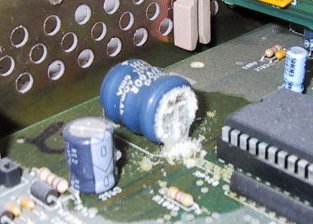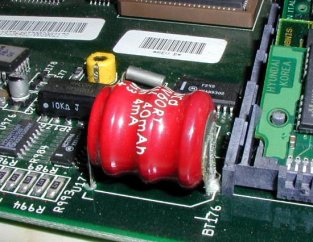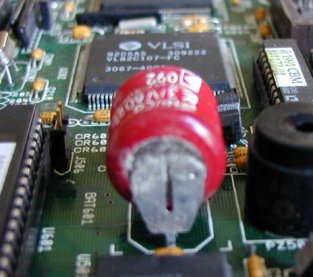Most Amigas use a rechargeable 3.6 volt NiCd battery to keep the clock operating when the Amiga is switched off. These batteries deteriorate with age and most have now started to leak corrosive fluids. These fluids will eat away the copper tracks of circuit boards and destroy ICs and other components, ruining your Amiga.
It is essential that you lift the lid on your Amiga and have a look. The A500 range of computers has the battery on the expansion ram board. Big Box Amiga's have the battery on the motherboard.
Not convinced? Well look at these pictures:-
|
This is a really bad A2000/A1500 battery above. This battery was on the verge of creating major mahem on the motherboard. Seepage had got onto the pins on the 68000 and many of the motherboard tracks were beginning to suffer. This took a lot of remedial action to cure. |
|
|
|
Above we have an A4000 battery that has just started to leak. Notice the white deposits at the motherboard end of the right hand battery leg. This one only needed minor cleaning. On the left we have an A2386 Bridgeboard which again had just started to leak and needed minor surgery. |
If you have a leaking battery, it is vital it be removed immediately. Ensure you replace it with a new one second hand is false economy. Maplin Electronics and RS components in Britain both sell these batteries at about £3 each. As I am sure you can appreciate this is a small price to pay to keep your Ami working. The only downside if you are a purist is that the new batteries are NiMh instead of NiCd but at the end of the day a NiMh battery is much better than the NiCd and is much less likely to leak. The type of battery you are looking for is the 3/V80H. This repair does mean soldering your motherboard. Remove the motherboard from the case (after disconnecting the mains power!). Unsolder the old battery and clean all signs of spilt liquid from the area with electronic cleaning fluid or methylated spirits. To get into all the nick and crannies use an old toothbrush. Using the toothbrush, scrub the area with some dilute vinegar (to neutralise the alkaline spillage). Finally scrub again with cleaning solvent or methylated spirits and then clean water. Don't forget to check underneath the PCB as well as seepage will more often than not gone here too. If your motherboard looked like the A2000 motherboard above then you need to clean the affected area of the PCB in hot water and scrub the area with a toothbrush and a dash of detergent after doing the earlier steps. Repeat and finish with a long rinse in the hottest water you can stand. Try to ensure you dont get water in the chip sockets or any variable resistors or you will have alsorts of other troubles. Shake the board vigorously and leave it to dry in a warm place for a day or two. Solder in the new battery, observing the same polarity as the old one. If you are still using a NiCd battery, you may want to consider mounting it remotely and running wires to the motherboard so that if it leaks again, it will cause less damage. Though if you decide to stick with a NiCd you should also ensure you mount it where it wont be over the motherboard.


